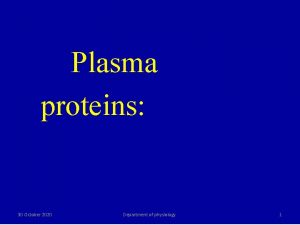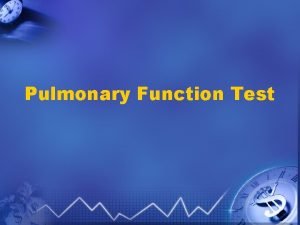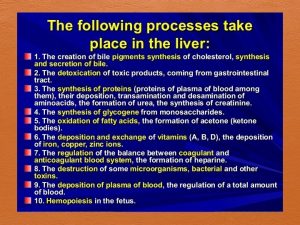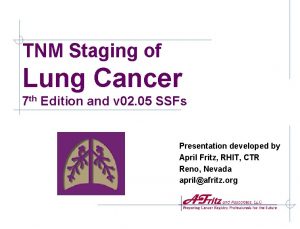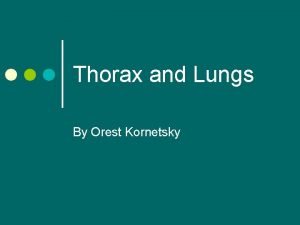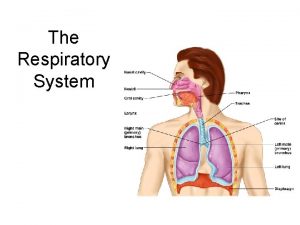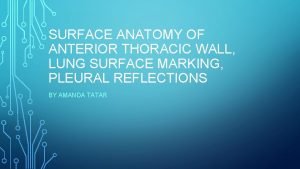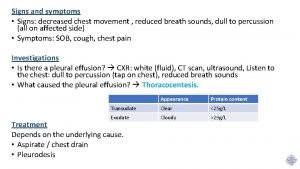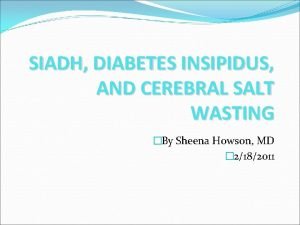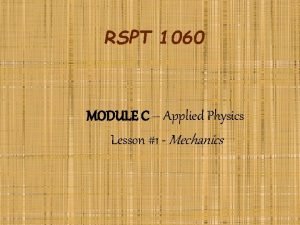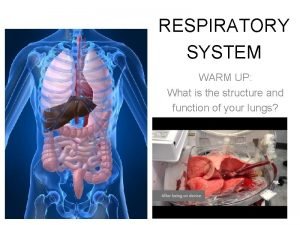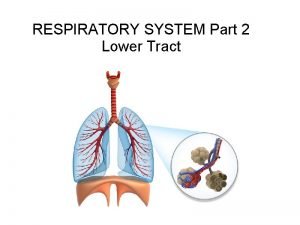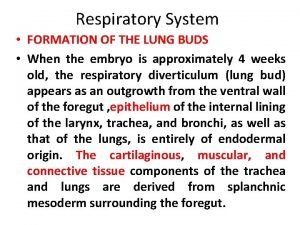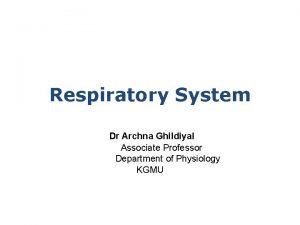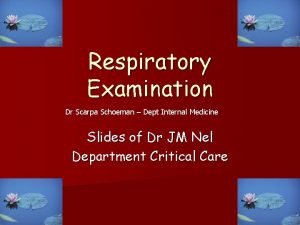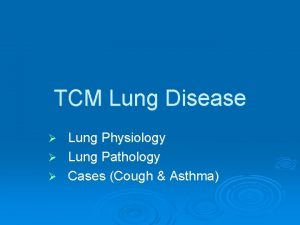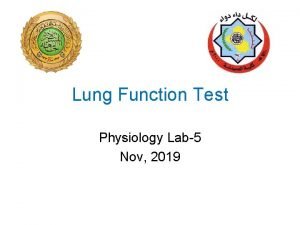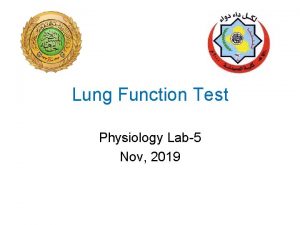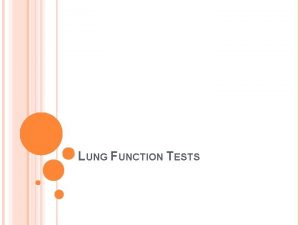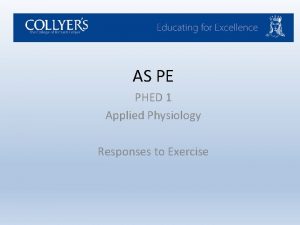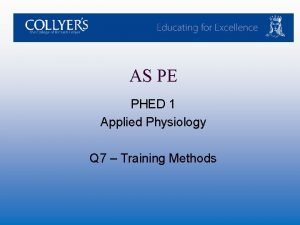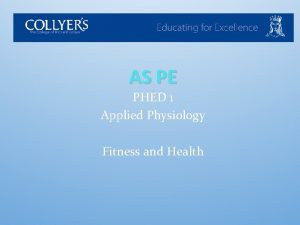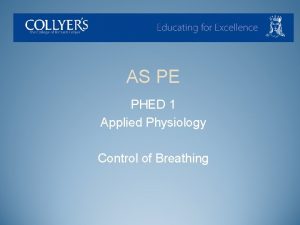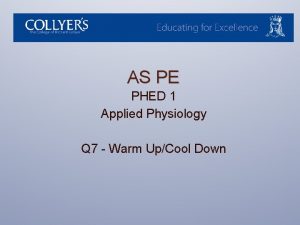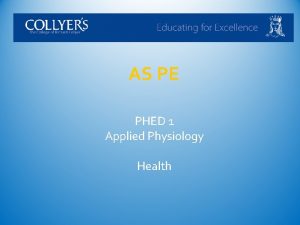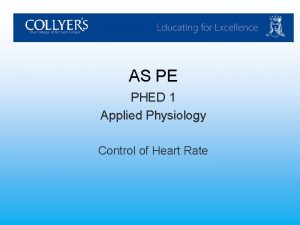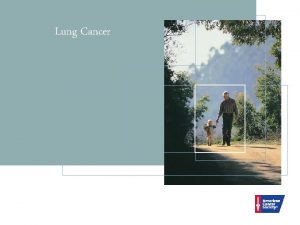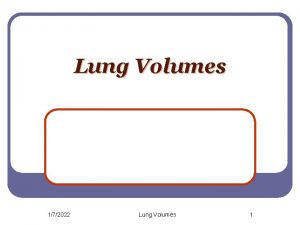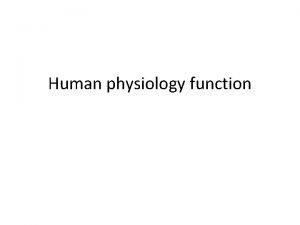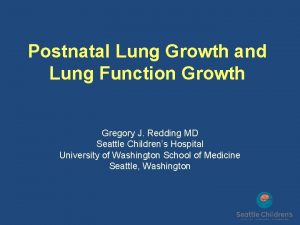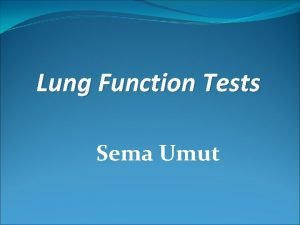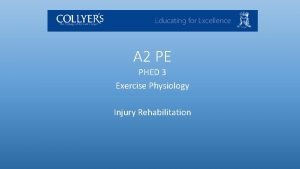AS PE PHED 1 Applied Physiology Lung Function



















- Slides: 19

AS PE PHED 1 Applied Physiology Lung Function

Lung Function Learning Objectives 1. To understand the key terminology of lung function 2. To be able to explain how inspiration and expiration occur 3. To understand how these process are effected by physical exercise and training

NASAL CAVITY MOUTH PHARY NX LARYNX (VOICE BOX) TRACHEA RIGHT LUNG BRONCHILOE S DIAPHRAGM BRONCHU S ALVEOLI

Route of Air through Respiratory System You will not be examined on the structure of the respiratory system but need to have a basic route of an air particle: �Nasal Cavity �Larynx �Trachea �Bronchus �Bronchioles �Alveoli/Air sacs structure of respiratory system

Mechanics of Breathing �Air moves from areas of high pressure to areas of low pressure. �To breathe in the air pressure in the lungs must be lower than the pressure in the atmosphere. �Atmospheric pressure is 100 k. Pa. When we inspire we lower the air pressure in alveoli to 99. 74 k. Pa. �This causes air to flow in.

Inspiration �During inspiration we lower the air pressure in our lungs by increasing the volume of the lungs. �At rest (quiet breathing) this is done by the diaphragm contracting (flattening) and the intercostal muscles lifting the ribcage up and out. �This is an active process.

Expiration �When at rest expiration is a passive process. �The intercostal muscles and diaphragm relax. �Volume of thoracic cavity decreases. �Air pressure in the lungs increases. �Air is forced out.

Inspiration during Exercise �During exercise both rate and depth of breathing increase. �Inspiration increases through greater expansion of the thoracic cavity. �The amount of air inspired in one breath (tidal volume) can rise from 0. 5 L to 3. 5 L. �Breathing rate can rise from 12 -15 breaths per minute to 60.

Expiration during Exercise �During exercise expiration becomes an active process. �The intercostal muscles contract to pull the ribcage in and down, whilst the abdominals assist the diaphragm in pushing up.

Lung Volumes and Capacities Volume Name Description Value at rest (ml) Change during exercise Tidal Volume (TV) Inspiratory Reserve Volume (IRV) Expiratory Reserve Volume (ERV) Vital Capacity (VC) Residual Volume (RV) Total Lung Capacity lung volumes and capacities explained (1. 10 onwards)

Lung Volumes and Capacities Volume Name Description Tidal Volume (TV) Amount of air breathed in or out per breath Inspiratory Reserve Volume (IRV) Maximal amount of air forcibly inspired in addition to tidal volume Expiratory Reserve Volume (ERV) Maximal amount of air forcibly expired in addition to tidal volume Vital Capacity (VC) Maximal amount of air exhaled after a maximal inspiration (TV + IRV + ERV) Residual Volume (RV) Amount of air left in lungs after a maximal expiration Total Lung Capacity Vital capacity plus residual Value at rest (ml) Change during exercise

Lung Volumes and Capacities Volume Name Description Value at rest (ml) Tidal Volume (TV) Amount of air breathed in or out per breath 500 Inspiratory Reserve Volume (IRV) Maximal amount of air forcibly inspired in addition to tidal volume 3100 Expiratory Reserve Volume (ERV) Maximal amount of air forcibly expired in addition to tidal volume 1200 Vital Capacity (VC) Maximal amount of air exhaled after a maximal inspiration (TV + IRV + ERV) 4800 Residual Volume (RV) Amount of air left in lungs after a maximal expiration 1200 Total Lung Capacity Vital capacity plus residual 6000 Change during exercise

Lung Volumes and Capacities Volume Name Description Value at rest (ml) Change during exercise Tidal Volume (TV) Amount of air breathed in or out per breath 500 Increases Inspiratory Reserve Volume (IRV) Maximal amount of air forcibly inspired in addition to tidal volume 3100 Decreases Expiratory Reserve Volume (ERV) Maximal amount of air forcibly expired in addition to tidal volume 1200 Decreases Vital Capacity (VC) Maximal amount of air exhaled after a maximal inspiration (TV + IRV + ERV) 4800 Slight increase Residual Volume (RV) Amount of air left in lungs after a maximal expiration 1200 None 6000 None Total Lung Capacity Vital capacity plus residual

Minute Ventilation (VE) The amount of air moved in and out of the lungs in one minute. VE = Breathing Rate x Tidal Volume (ml) At Rest: VE = 12 x 500 ml = 6 L/min During Exercise: VE = 60 x 3000 ml = 180 L/min

Gas Exchange �Diffusion occurs when gases move from an area of high concentration (partial pressure) to an area of low concentration. �The partial pressure of O 2 (PO 2)in the alveoli is high, the PO 2 in blood returning from the heart to the lungs is low. �O 2 diffuses across the semi-permeable alveoli walls into the bloodstream. �It combines with haemoglobin in RBC to form oxyhaemoglobin (oxygenated blood). �The movement of CO 2 occurs in exactly the same way but in the opposite direction.

Factors Ensuring Efficient Respiratory Diffusion �Permeability of alveoli and capillary cell walls. �Short distance from alveoli to capillary. �Readiness of haemoglobin to combine with O 2. �Diffusion gradient caused by different partial pressures. �Large surface area of alveoli. �Slow movement of blood through thin narrow capillaries.

Diffusion of O 2 in Muscle Cells �O 2 diffuses from the oxygenated blood (in capillaries) into muscle cells. �Here in combines with myoglobin to form oxymyoglobin and goes to the mitochondria. �During exercise the muscles use more O 2 to create energy. This lowers PO 2 in muscle cells, increasing the rate of diffusion. �At the same time more CO 2 is produced and so the rate of diffusion of CO 2 in the opposite direction increases.

How Breathing is Controlled �The rate and depth of breathing is controlled by the medulla oblongata. During exercise: �Both chemical and neural influences cause an increase in breathing rate and depth. Chemical changes include: �An increase in CO 2 in blood (making it more acidic), and an increase in lactic acid production. �Changes in blood acidity are detected by chemoreceptors. �It is the change in CO 2 (and O 2) levels that has an affect on respiration.

Neural influences include: �Activity from the brain caused by anticipation of exercise. �Increased stimulation from proprioceptors in joints and muscles as a result of physical movements. �Increased body temperature.
 Phed phed rosebery
Phed phed rosebery Applied physiology
Applied physiology Pulmonary function test 判讀
Pulmonary function test 判讀 Function of liver physiology
Function of liver physiology Lung compliance formula
Lung compliance formula Tnm staging lung cancer
Tnm staging lung cancer Tnm staging lung
Tnm staging lung Tactile fremitus test
Tactile fremitus test Regio thorax
Regio thorax Lung membrane
Lung membrane Surface anatomy of thoracic wall
Surface anatomy of thoracic wall What causes lungs pain
What causes lungs pain Siadh vs diabetes insipidus
Siadh vs diabetes insipidus Normal lung compliance
Normal lung compliance Lung compliance formula
Lung compliance formula Lungs 3 lobes
Lungs 3 lobes Right lung lobes
Right lung lobes Lung bud
Lung bud 3 types of lung receptors
3 types of lung receptors Ap diameter of chest
Ap diameter of chest

